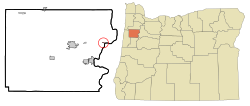Eola, Oregon
| Eola, Oregon | |
|---|---|
| Census-designated place (CDP) | |

Former 1937 school in Eola
|
|
 Location of Eola, Oregon |
|
| Coordinates: 44°55′55″N 123°7′7″W / 44.93194°N 123.11861°W | |
| Country | United States |
| State | Oregon |
| County | Polk |
| Area | |
| • Total | 0.1 sq mi (0.2 km2) |
| • Land | 0.1 sq mi (0.2 km2) |
| • Water | 0.0 sq mi (0.0 km2) |
| Elevation | 230 ft (70 m) |
| Population (2010) | |
| • Total | 45 |
| • Density | 767.0/sq mi (296.1/km2) |
| Time zone | Pacific (PST) (UTC-8) |
| • Summer (DST) | PDT (UTC-7) |
| FIPS code | 41-23550 |
| GNIS feature ID | 1161035 |
Eola is an unincorporated community in Polk County, Oregon, United States four miles west of Salem on Oregon Route 22 at the confluence of Rickreall Creek and the Willamette River.
For statistical purposes, the United States Census Bureau has defined Eola as a census-designated place (CDP). The census definition of the area may not precisely correspond to local understanding of the area with the same name. The population of the CDP was 49 at the 2000 census. It is part of the Salem Metropolitan Statistical Area.
The Eola Hills rise north of the community and were named after it.
Eola was originally named Cincinnati in 1844 by settlers Joshua "Sheep" Shaw and his son, A. C. R. Shaw, who thought the site resembled Cincinnati, Ohio, where Joshua once lived. Joshua Shaw earned his nickname by being the first person to bring sheep overland to the Oregon Country via the Oregon Trail, also in 1844.
Cincinnati post office was established in 1851, the first stop on a 70-mile mail route that included Nathaniel Ford's home in Rickreall and Nesmith's Mills at Ellendale.
The Oregon Territorial Legislature incorporated the community with the name "Eola" in 1856. The name comes from Aeolus, Greek god of the winds, though the reason for the name change is disputed.
...
Wikipedia
